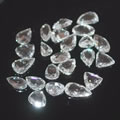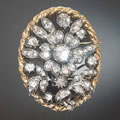 Developed in the 16th century, the rose cut has a flat bottom and domed top covered with triangular facets. The outline varies, but rose cuts are most typically round, oval, triangular or pear-shaped. In the 17th century, they gained greater acceptance and their facet arrangement became less random. Variations were always in multiples of six, such as a six-facet rose, an 18-facet rose and the full rose cut, which has a lower tier of 18 facets and upper tier of six facets coming to a point at the apex, which makes it look like a rosebud just starting to open.
Developed in the 16th century, the rose cut has a flat bottom and domed top covered with triangular facets. The outline varies, but rose cuts are most typically round, oval, triangular or pear-shaped. In the 17th century, they gained greater acceptance and their facet arrangement became less random. Variations were always in multiples of six, such as a six-facet rose, an 18-facet rose and the full rose cut, which has a lower tier of 18 facets and upper tier of six facets coming to a point at the apex, which makes it look like a rosebud just starting to open.
 The brilliant cut supplanted the rose cut in the 19th century. The rose returned at the turn of the 20th century, when jewelry drew inspiration from 18th century Baroque styling, but went out of favor again after 1910 when styles moved toward Art Deco. For almost a century, the rose cut has been in retirement, popping up only occasionally.
The brilliant cut supplanted the rose cut in the 19th century. The rose returned at the turn of the 20th century, when jewelry drew inspiration from 18th century Baroque styling, but went out of favor again after 1910 when styles moved toward Art Deco. For almost a century, the rose cut has been in retirement, popping up only occasionally.
 There are old and new Rose Cuts on the market and the diamond industry is seeing a revival of interest. Older Rose Cuts range from 70 to 200 years old and are distinguished by a knife-edge girdle and an irregular shape. There are rarely calibrated (exact millimeter sizes) older Rose Cuts, so a calibrated one is likely to be newly cut. Newer stones are being cut primarily in India and most of the current supply of Rose Cut diamonds is new.
There are old and new Rose Cuts on the market and the diamond industry is seeing a revival of interest. Older Rose Cuts range from 70 to 200 years old and are distinguished by a knife-edge girdle and an irregular shape. There are rarely calibrated (exact millimeter sizes) older Rose Cuts, so a calibrated one is likely to be newly cut. Newer stones are being cut primarily in India and most of the current supply of Rose Cut diamonds is new.
 The crown is cut with triangular facets to bring brilliance and reflection like a rose flower. This allows more light to pass through the stone than a full-cut diamond, where cutting is based on contemporary knowledge of the optics of refractivity and reflectivity. The spread of the Rose Cut is almost one-an-one-half times or more than that of a full-cut diamond.
The crown is cut with triangular facets to bring brilliance and reflection like a rose flower. This allows more light to pass through the stone than a full-cut diamond, where cutting is based on contemporary knowledge of the optics of refractivity and reflectivity. The spread of the Rose Cut is almost one-an-one-half times or more than that of a full-cut diamond.
 A strong avenue for Rose Cuts is their use in antique or estate replacement jewelry, as there is still good demand in this arena. Contemporary jewelry designers are using Rose Cuts in all categories of jewelry, especially solitaire and fashion rings, earrings and necklaces, as well as in watchcases.
A strong avenue for Rose Cuts is their use in antique or estate replacement jewelry, as there is still good demand in this arena. Contemporary jewelry designers are using Rose Cuts in all categories of jewelry, especially solitaire and fashion rings, earrings and necklaces, as well as in watchcases.
Excellent older Rose Cuts, which usually have more brilliance, are sold with a premium price reflecting their relative rarity. Big, clean stones are also in demand. Matched pair Rose Cuts and layouts for necklaces or bracelets are also priced higher because of the difficulty of matching shapes, colors and qualities.

